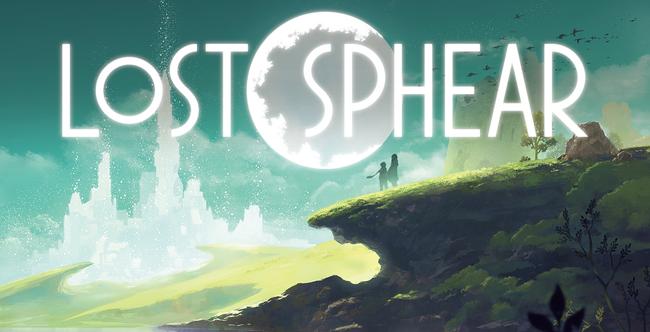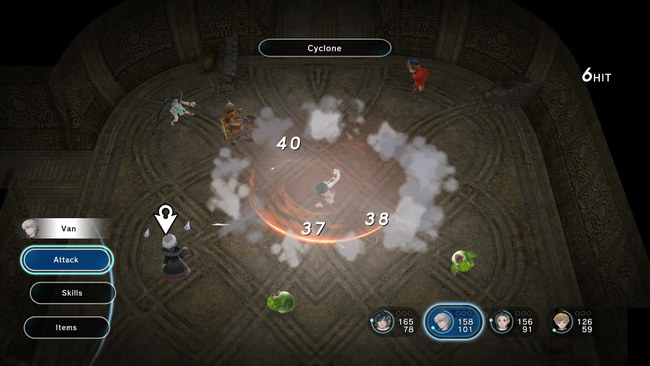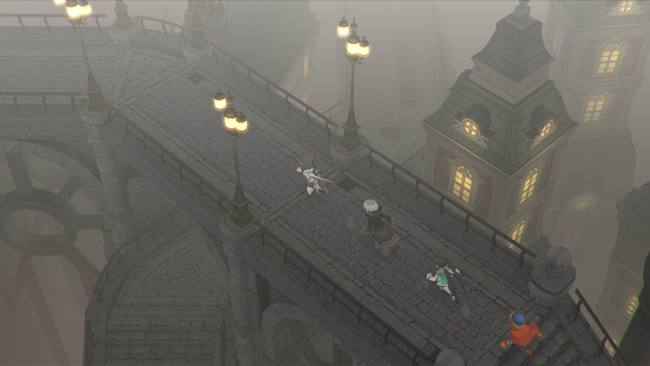
Lost Sphear will have new features as well as revamping features from I Am Setsuna
UPDATE: Dengeki Online has a more complete version of the interview, and we have added translations of segments missing in the magazine.
Square Enix's Tokyo RPG Factory has recently revealed Lost Sphear, the second RPG in their Project Setsuna after I Am Setsuna which was released in 2016. This week's Dengeki PlayStation magazine has an interview with Atsushi Hashimoto, the director for both I Am Setsuna and Lost Sphear, and we have fully translated the interview which you can read right after the jump.

Getting the zeal of RPGs in the 90’s once more!
Dengeki : This game is the second part in “Project Setsuna”, but please tell us of its concept once again.
Hashimoto: Just like the first part “I Am Setsuna”, we’re producing this with the concept of re-enacting the style and fun factor felt from RPGs in the 90’s to match the current era.
Dengeki : It seems like there is no gap between the previous game, but from what time did you start working on this?
Hashimoto: We started the discussions at around just after the release of the previous game. After that the Switch version was being progressed concurrently, but we didn’t make the periods [of development for both games] clash in particular.
Dengeki : The spelling of “SPHEAR” in the title is a bit different from usual though…?
Hashimoto: Actually, it is the archaic wording of “SPHERE” which has been used in general. As the production progresses, we’re gradually able to put a meaning to “SPHEAR”, and finally it became like this. If you’re wondering what kind of meaning it has, please kindly play it and check it out for yourself.
Dengeki : Is there a connection in the world setting with “I Am Setsuna”?
Hashimoto: This time it’s a brand new game, so we’re creating it without bothering about any connections at all. However, we have no intentions to deny imaginations from users either. We’re leaving some space for imagination, so I hope you’ll consider about a lot of things. Of course we’ve made the contents so that there would be no problem at all even if you don’t know about the previous game.
Dengeki : The previous game had a casual response, but how the volume will be like in this game?
Hashimoto: We planned to make it about the same, but when we actually made it the volume became bigger than we thought. The previous game was said to be clearable in around 20 hours, but this game should take about 30 hours, or 40-50 hours with replay value. The concept of making a game with volume that can be cleared easily is not being changed.
Dengeki : On creating this game, do you have any hardships that you didn’t have in the previous game?
Hashimoto: While this is a brand new game, we did a lot of discussions on the balance of how far we should be doing things, so that it won’t betray expectations of people who have played the previous game “I Am Setsuna”.
Dengeki : By the way “I Am Setsuna ” is the foreign title for what’s known as “Setsuna of Sacrifice and Snow” in Japan, but why did you go with this title?
Hashimoto: The title “Setsuna of Sacrifice and Snow” had a very Japanese presentation so it was really difficult for us to convey it in English. Also the nuance of the word “Setsuna” is hard to convey, so we went with this title to be able to convey that this is the name of a person.

The World shaped by “Memories” which are inhibited by all things
Dengeki : In the previous game the image of snow sceneries was strong, but this time what kind of thing will become the main image?
Hashimoto: The image of the Moon is being strongly pushed out, and it also appears in the main visual. It will also have an important part in the story. There are also scenes where [characters] look at the Moon, as well as gimmicks related to nights with the Moon. Furthermore there is also mechanical city as one of the locations.
Dengeki : What does “Rebuilding World Memory RPG” mean? Also, please tell us in concrete about the power to rebuild the world with memories, which the protagonist has.
Hashimoto: The world in this game is formed by things and people, by joining “Particles” with “Star Memories” which are information owned by the world. The “Lost Phenomenon” is the “Star Memories” falling out, causing people and things to be unable to preserve their forms. The protagonist Kanata has the power to rewrite or repair those “Star Memories”.
Dengeki : Story-wise, does it mean the protagonist is going to solve the “Lost Phenomenon”?
Hashimoto: That’s right. It may be hard to image it, but you can think of it as the world being assailed by strange phenomenon where people and things suddenly become pure white. The protagonist is the only one being who can repair that phenomenon.
Characters with personalities that play the story
Dengeki : Please tell us about the roles of each of the 4 characters that have been revealed.
Hashimoto: The protagonist is the central person of this story, who has the “power to rebuild the world with memories”. He doesn’t assert about it himself, but he’s not indecisive either, so he becomes a neutral character. His childhood friends are Lumina who straightens jokes, and Rock who is a mood maker. The story begins from the incident happening to the city the three live in. Van is a mysterious man who appeared when the incident happened to the city, and he will also have a very important role in the story.
Dengeki : Van’s weapons are a rare thing indeed.
Hashimoto: They have the image of floating around and beating enemies, so we made them into mechanical-like weapons that are controlled with the power of mind. So the image from the name “Bits” become weapons as is.

The battle [system] inherits ATB 2.0 and evolves it
Dengeki : Just like in the previous game, [the battle system] is based on Chrono Trigger’s ATB (Active Time Battle), but what’s the reason of using ATB again this time?
Hashimoto: It’s a result of improving it based on the previous game “I Am Setsuna”. However, there were also things that we could see when producing the previous game, so we reviewed almost everything. For example the system for running away. The well-received Setsuna system is also being inherited, but this is also being changed a bit. I still can’t tell you in detail yet, but in this game it will be linked with customizations.
Dengeki : The particularly big one among them would be being able to move during battles. Is that so after all?
Hashimoto: That’s right. Being able to move during battles is a really big point. You can do things like including many enemies within [your character’s] attack range, or running away from enemies’ attack range. However it doesn’t mean you cannot win if you don’t utilize it, so it’s just an auxiliary feature after all. I think it can be also enjoyed by light (casual) users.
Dengeki : Are there any other new systems?
Hashimoto: If you take a good look at some of the screenshots, you should be able to see a mysterious gauge. We’re preparing a bit of gimmick there, so please look forward to the future announcements. Perhaps people with good intuition might be able to figure it out if they take a good look at the screenshots!?
Dengeki : By the way what’s the maximum number of people that can participate in battles?
Hashimoto: You can do battles with a party of up to 4 people. 1 slot has been added from the previous game, so I think you should be able to add more variations to the party. If it’s just 3 slots, a lot of people would put in the hero and heroine, so only 1 slot would remain. For example a character with extreme [tendencies] such as ‘specializing in healing’ would be difficult to put into a party with 3 character slots. So considering that, we added them to 4.
Well-received systems are being evolved and inherited
Dengeki : In the previous game the drops change with the Kill method, but does that gimmick also exist in this game?
Hashimoto: It was well received in the previous game, but we think it ended up creating gaps among players, so this time drops would not change with the Kill method. However, we’re still properly keeping such replay values intact.
Dengeki : How will the growth system be like in this game?
Hashimoto: Basically we’re basing it on Setsuna then improving it from there. It’s also the same for the Spritnites.
Dengeki : In the previous game, the BGMs which were played by piano left an impression. But what kind of BGMs will be in this game?
Hashimoto: It was well-received in the previous game, so we’re still keeping the piano in this game, while pairing it up with some sort of other instrument. There are various instruments we’re pairing up, but I hope throughout the game you will get to enjoy BGMs with a sense of unity, with piano as the main constituent.
Dengeki : How about the timeframe for the release date?
Hashimoto: It’s being planned for around Fall 2017 [in Japan; Western release is slated for Early 2018]. We will unlock various information while heading towards there, so please notice them in the future.
Dengeki : Please leave a message to the users who are looking forward to this.
Hashimoto: Since this is Tokyo RPG Factory’s second game, we’re producing an RPG that has popular 90’s RPGs as the foundation and evolve further from there with our utmost efforts. In the term “Neo Traditional RPG” which is the genre of this game, we’re putting in our thoughts to provide a new RPG that also inherits from traditional RPGs to users. We’re putting our spirit on creating it, so please kindly look forward to it!

Lost Sphear will be released for PlayStation 4 and Nintendo Switch in Fall 2017 in Japan. The Western release in early 2018 will also receive an additional Steam version. You can also read the initial information batch for Lost Sphear here.